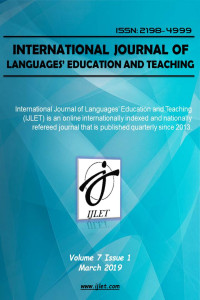An Assessment of Social Interaction Responsiveness of Selected Online Resources for French Vocabulary Learning by Foreign Learners
Öz
This paper investigates the appropriateness of Internet-based learning resources in the acquisition of
French vocabulary by foreign learners using the framework of the social interaction theory of learning.
Five online French language learning platforms are randomly selected and an assessment of their
responsiveness to the framework of the social interaction theory of foreign language learning is
carried out. Findings show that the five online resources, although not on the same level of interactive
effectiveness, would be of great assistance to foreign learners of French in their quest to acquire
adequate vocabulary. Finally, far-reaching recommendations are made to developers of online
vocabulary learning resources on how to best present their learning contents for optimal results.
Recommendations are also made to French teachers and learners on ways by which the use of online
platforms can be optimally utilized to facilitate the acquisition of French vocabulary.
Anahtar Kelimeler
Social interaction more knowledgeable others zone of proximal development French vocabulary online learning resources.
Kaynakça
- Abraham, L. B. (2008). Computer-mediated glosses in second Language reading comprehension and vocabulary learning: A meta-analysis. Computer Assisted Language Learning, 21(3), 199–226.
- Aslim-Yetis, V. (2010). Internet for foreign language teaching: An experiment with French learners. H.U. Journal of Education, 39, 44-56.
- Barrs, K. (2012). Fostering computer-mediated L2 interaction beyond the classroom. Language Learning & Technology, 16(1), 10–25.
- Blake, R. (2000). Computer-mediated communication: a window on l2 Spanish interlanguage. Language Learning & Technology, 4(1), 120–136.
- Chanier, T. & Selva T. (1998). The Elexia System: The use of visual representations to enhance vocabulary learning. Computer Assisted Language Learning, 11 (5), 489-521
- Chun, D. M. (1994). Using computer networking to facilitate the acquisition of interactive competence. System, 22 (1), 17-31.
- Chun, D.M. & Plass J. (1996). Effect of multimedia annotations on vocabulary acquisition. The Modern Language Journal, 80 (ii), 183-198.
An Assessment of Social Interaction Responsiveness of Selected Online Resources for French Vocabulary Learning by Foreign Learners
Öz
Anahtar Kelimeler
Social interaction more knowledgeable others zone of proximal development French vocabulary online learning resources.
Kaynakça
- Abraham, L. B. (2008). Computer-mediated glosses in second Language reading comprehension and vocabulary learning: A meta-analysis. Computer Assisted Language Learning, 21(3), 199–226.
- Aslim-Yetis, V. (2010). Internet for foreign language teaching: An experiment with French learners. H.U. Journal of Education, 39, 44-56.
- Barrs, K. (2012). Fostering computer-mediated L2 interaction beyond the classroom. Language Learning & Technology, 16(1), 10–25.
- Blake, R. (2000). Computer-mediated communication: a window on l2 Spanish interlanguage. Language Learning & Technology, 4(1), 120–136.
- Chanier, T. & Selva T. (1998). The Elexia System: The use of visual representations to enhance vocabulary learning. Computer Assisted Language Learning, 11 (5), 489-521
- Chun, D. M. (1994). Using computer networking to facilitate the acquisition of interactive competence. System, 22 (1), 17-31.
- Chun, D.M. & Plass J. (1996). Effect of multimedia annotations on vocabulary acquisition. The Modern Language Journal, 80 (ii), 183-198.
Ayrıntılar
| Birincil Dil | İngilizce |
|---|---|
| Konular | İkinci Bir Dil Olarak İngilizce |
| Bölüm | Araştırma Makalesi |
| Yazarlar | |
| Yayımlanma Tarihi | 30 Mart 2019 |
| Yayımlandığı Sayı | Yıl 2019 Cilt: 7 Sayı: 1 |


